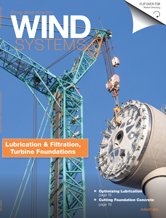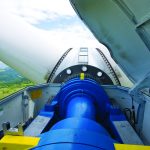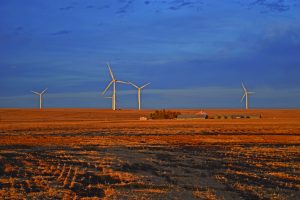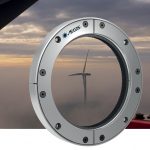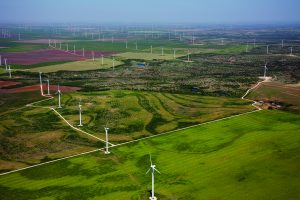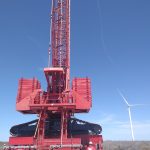Since each rolling bearing in a wind turbine operates under different conditions, it often is assumed using a variety of lubricants is essential for serving all of them.
For operators, this means not only added logistical efforts and expensive warehousing but also the increased risk of product mix-ups.
Some newly developed greases can be used for all rolling bearings in a wind turbine. Often, they not only meet all requirements of main, generator, yaw, and rotor-blade bearings, but they also increase the turbine’s operational reliability considerably. Combined with a white adhesive lubricant used for the open yaw and pitch-blade gears, only two special lubricants are needed to cover all relevant, grease-lubricated friction points in a wind turbine.

Wind-Power Plant Lubrication
The most important bearings in a wind turbine — such as the main, generator, yaw, and blade bearings — each operate under different conditions, leading to different requirements for the lubricant.
Operators of wind-power plants frequently have to use different types of grease to satisfy each requirement. Additionally, service companies have to take into account different lubricant recommendations for each turbine manufacturer and turbine model. The result is increased expenses for logistics, warehousing and grease disposal, as well as the constant risk of lubricant mix-up. Certain lubricants also may not be available in some locations worldwide.
One Solution
The different requirements of each bearing can be met by a single product without compromising lubricant performance.
A single-use lubricant, consisting of a special mix of base oils and a purpose-developed additive package, includes a service temperature range of minus-40 to 150 degrees Celsius. This is attained through a mix of synthetic and mineral base oils, allowing the lubricant to remain stable at higher temperatures and giving the bearing a longer life.
Any product containing only mineral oil likely would fall short of these requirements. With a wider range than the actual temperatures in wind turbines, it can offer some reassuring reserve capacity, leading to slower grease aging and longer relubrication intervals.

Wear also occurs while the turbine is standing still or running at low speed, since a sufficient hydrodynamic lubricant film cannot form under these conditions. To counter this effect, a single-use lubricant can be fitted with suitable additives to prevent damage, even if the damage is caused only by vibrations.
Other critical factors for trouble-free wind-turbine operation include good pumpability in accurate quantities with centralized lubricating systems, as well as good grease distribution and defined oil release.
Single-use lubricants offer good compatibility with all commercial sealing elastomers. Comprehensive tests have shown that due to its specific combination of base oil and thickener, any mixing with other bearing greases does not cause critical reactions, which makes lubricant changeover much easier.
Cost Comparison
The costs from bearing damage should not be underestimated. In addition to material and labor costs for replacing a damaged bearing, operators also must consider possible lead time for parts and/or tools, and the loss of production.

These factors combined can contribute to a steep increase in costs. For example, if a damaged generator bearing causes damage to the generator itself, repair and replacement costs will be in the thousands of dollars. In comparison, the cost of a single-use lubricant that helps improve plant reliability and avoid unplanned downtime are all but negligible.
The Work of a Multitude of Greases
Another set of lubricant-demanding components in wind turbines are the yaw and blade gears with their open teeth. At many sites, one-wind direction is dominant, and the pitch angle remains relatively similar. This leads to only a small portion of the gear teeth being in contact a majority of the time. The transmission of power to adjust the nacelle and blades often are limited to only a few teeth.
Lubricants of extremely high load-carrying capacity offer elevated and reliable protection against wear. Apart from that, gear teeth not in mesh have to be protected against corrosion.

Most open gears in wind-power plants are still lubricated by hand. However, maintenance has to be reduced in order to keep downtime to a minimum. For this purpose, central lubrication systems are used increasingly for the relubrication of the open gears. These adhesive lubricants, which by their nature are viscous, have to ensure good pumpability even at low operating temperatures.
Added-Value Concept
While friction will never be eliminated fully, single-use lubricants can sufficiently cover all relevant grease-lubricated friction points in a wind turbine. This added-value concept has proven successful in many wind-power plants for several years. It allows plant operators to make maintenance routines easier and reduce storage costs. Due to the high performance of single-use lubricants, downtime can be reduced and the effectiveness, and hence the yield, of wind-power plants can be increased.
Source Klüber Lubrication NA LP
For more information, contact Jesse Dilk or Jestin Hulegaard with Klüber Lubrication at www.klueber.com.
















